
Official Edgar Rice Burroughs Tribute and Weekly Webzine Site
Since 1996 ~ 15,000 Webpages in Archive
Volume 1413
Presents

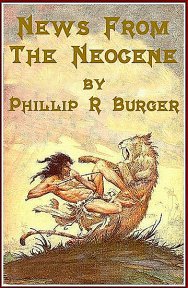 |
and the Layman Popular Science
Phillip R. Burger |
 |
While it has been popular over the years to speculate upon which fiction authors may have inspired Edgar Rice Burroughs to create his particular brand of "scientific romance," perhaps the greatest single influence upon his artistic vision was Charles Darwin and the theory of evolution. Nowhere is this more evident than in The Land That Time Forgot, which first appeared as a three part magazine serial in 1918. Depicting a lost continent where all humans undergo the evolutionary transformation from ape-like progenitor to modern man, The Land That Time Forgot represents the fullest expression of Burroughs' belief in evolution as "an immutable law of God."
Darwin's influence was felt not only in the sciences but throughout late nineteenth-century society as a whole. Many theories and ideas -- particularly those regarding human development and evolution -- so fired the Victorian imagination that they became part of the cultural background (some of these ideas linger to this day).
In creating LTTF's elaborate evolutionary cycle Burroughs tapped into this pool of popular scientific thought. Burroughs wrote for the average reader, and so his "science" would be of a level that his audience was comfortable with. What I wish to do is highlight some of the possible sources Burroughs used in developing his novel and how he created a unique window through which to view early twentieth century America's interest in evolutionary theory and natural history.
Inspired by the sinking of the British passenger liner Lusitania, which was attacked by a German submarine on May 7th, 1915, Burroughs launches The Land That Time Forgot by sending a U-boat crew and its captors to Caprona (Caspak to its inhabitants), a large volcanic island situated somewhere in the southern Pacific. Protected by high cliffs and warmed by the earth's inner fires, Caprona harbors life forms covering the entire history of the natural world, including the entire spectrum of human evolution. Burroughs breaks human evolution into seven general phases:
I. Ho-lu, or ape-men.While these various races live separate from one another they are nonetheless intimately connected, for on Caprona each human individual evolves; that is, the ape-man on the lowest rung of this evolutionary ladder has the potential over time to physically change to an Alu, then to a Bo-lu, and so on up to pre-civilized man.
II. Alu, or speechless men (analogous to "Piltdown" man).
III. Bo-lu, or club-men (analogous to Neanderthal man).
IV. Sto-lu, or hatchet-men.
V. Band-lu, or spear-men (analogous to Cro-Magnon man).
VI. Kro-lu, or bow men.
VII. Galu, or rope men (modern primitive man).Rather like frogs, human Capronan females bathe in tepid pools to lay their eggs, which are swept to a great inland sea. Some of these eggs will grow into tadpoles or fish, while a few may continue to evolve into primitive air-breathing land dwellers. From there even fewer will evolve into apes and then up the long human evolutionary chain. Fewer still have the potential to pass through all evolutionary phases; many will remain in a lower cycle and be considered batu, or finished. Only the highest humans, the Galu, can bear live young. It is a fascinating image, one which causes protagonist Bowen Tyler to remark, "if I could return to civilization, I should have meat for the clergy and the layman to chew upon for years -- and for the evolutionists, too."
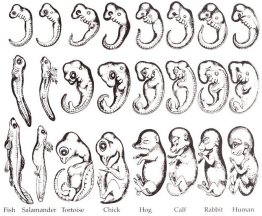
Haeckel-Inspired Drawings (click)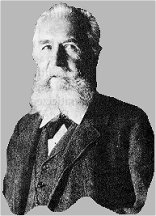
Ernst Haeckel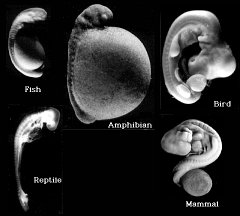
Actual Fetus PhotosBurroughs's grand seven-stage evolutionary cycle is, like the scientific trappings in his other romances, an amalgam of the various sciences Burroughs read over the years (paleontology, anthropology, geology and the like), filtered through his imagination and altered to suit his purposes. Many scientific theories were dispersed to the reading public via magazines and newspapers, and as such Burroughs probably did not know the men who first proposed the theories he utilized in The Land That Time Forgot. For starters take Ernst Haeckel and his biogenetic law. Haeckel (1834-1919), or "Darwin's German Bulldog," as he came to be called, was a prolific (if inaccurate) popular science writer3. You may never have heard of Haeckel, but his famous biogenetic law you will probably recognize right away:The history of the Germ is an epitome of the History of Descent, or, in other words: that Ontogeny is a recapitulation of Phylogeny; or, somewhat more explicitly: that the series of forms through which the individual Organism passes during its progress from the egg cell to its fully developed state, is a brief, compressed reproduction of the long series of forms through which the animal ancestors of the organism (or the ancestral forms of its species) have passed from the earliest periods of so-called organic creation down to the present time.In other words, as all of us were taking our amniotic nap in the womb we passed through our species' entire evolutionary history. Natural historian Stephen Jay Gould's nice summary of the law, eliminating Haeckel's turgid Victorian prose, provides a stronger visual image: "higher animals, in their embryonic development, pass through a series of stages representing, in proper sequence, the adult forms of ancestral, lower creatures. Thus the human embryo first develops gill slits, like a fish, later a three-chambered heart, like a reptile, still later a mammalian tail."
Haeckel articulated his theory as early as 1866. Darwin had actually expressed a similar notion in 1859, as had other scientists at various times, but Haeckel came up with a catchy phrase and so credit for the biogenetic law is given to him. "Ontogeny recapitulates Phylogeny," like "survival of the fittest," is a biological catch-phrase with which everyone is vaguely familiar, even though they may have no knowledge of where the phrase came from or what it really means. "Survival of the fittest," by the way, came from Herbert Spencer, not Darwin." Haeckel's belief that each individual creature passes through its evolutionary history during its gestational growth period sounded so sensible, so neat, that the idea was quickly adopted into popular thought.
Burroughs took this notion and with broad stokes spread his vision across the Capronan canvas. "From the egg, then, the individual developed slowly through various stages from a fish with gills to a frog with lungs ... If an egg survives it goes through all the stages of development that man has passed through during the unthinkable aeons since life first moved upon the earth's face." Burroughs took the elements of Haeckel with which most literate people of his day were familiar (egg to fish to frog) and replaced internal gestational development with external. He then carried Haeckel one step further by including the various known (or theorized) human developmental stages (Piltdown to Neanderthal to Cro-Magnon) in the design. Unfortunately for Burroughs' carefully wrought plans, there was little to no evidence to support Haeckel's theory. There had been many critics of the biogenetic law during the previous century, but Mendel's theory of genetics effectively torpedoed the law by 1900. No matter. Popular theories, however inaccurate they may be, die hard. They could still be the basis for a few good novels.
For Burroughs and readers of his generation, the biogenetic law was an accepted principle of popular scientific thought. In a 1925 article on the Scopes Monkey Trial Burroughs remarked with authority that "the entire evolution of the human race" is reproduced "within the womb of every mother." No need to elaborate upon the subject, everyone knew what Burroughs was talking about. And so in The Land That Time Forgot Burroughs took Haeckel's archaic law and juiced it up. All Capronans "go through a similar process of evolution outside the womb as develops our own young within." Burroughs' audacious concept was comprehensible to his audience and hence acceptable for a story of this type. "With that thought in mind Bradley discovered that it was not difficult to believe in the possibility of such a scheme -- there was nothing new in it." Indeed there was not.
Having grafted the development of homo sapiens upon Haeckel's basic idea, Burroughs needed to add the necessary prehistoric window dressing. If the readers were going to accept his fantastic evolution scheme the basic scientific background had to be believable. Here Burroughs did his homework, using recent texts for information on ancient man. In the nuts-and-bolts descriptions of human ancestors, as well as some details of their lifestyles and cultures, Burroughs roughly followed what was then known about our shaggy forebears. For example, here is how Burroughs describes Ahm the Bo-lu:
There was one among the lot, evidently the leader of them, who bore a close resemblance to the so-called Neanderthal man of La Chapelle-aux-Saints. There was the same short, stocky trunk upon which rested an enormous head habitually bent forward into the same curvature as the back, the arms shorter than the legs, and the lower leg considerably shorter than that of modern man, the knees bent forward and never straightened.The remains at La Chapelle-aux-Saints had been uncovered in 1908. The first Neanderthal bones had been discovered in 1856 in Germany's Neander Valley, hence the name, and perhaps LTTF's anti-German tone caused Burroughs to clarify his description with the words "so-called." Now compare Burroughs to Henry Fairfield Osborn's description in his Men of the Old Stone Age (1916):
The image of the shambling cave man was (and still is) part of popular folklore, made acceptable by such well-regarded science writers as H. G. Wells, who portrayed the Neanderthals as "The Grisly Folk" in his Outline of History. The debate raged as to whether Neanderthals were human ancestors or an inferior offshoot. Wells chose the latter, showing these troglodytes as finally being eradicated by "true men." (It is now generally agreed, although not for reasons of racial superiority, that Neanderthals were a separate branch of the homo sapien family.) Likewise, we cannot fault Burroughs for not knowing that the Piltdown find of 1911 would turn out to be a forgery (not proven until the 1950s). Even Osborn, a curator at the American Museum of Natural History, considered this "dawn man" relic "one of the most important and significant discoveries in the whole history of anthropology." A writer can only be as good as his sources.
Lewis Henry Morgan (1818-1881) was another man whose name Burroughs would probably be unfamiliar with but whose ideas were common coin in Victorian America. As biologists were busy cataloging all life into neat, orderly and comprehensible categories, so too were early anthropologists doing with human societies. For Morgan and other American anthropologists, the still-surviving Indian tribes represented a unique window into human ancestry. Study the Indians and you are studying our primitive forbearers. "The history and experience of the American Indian tribes," stated Morgan, "represent more or less nearly, the history and experiences of our own remote ancestors when in corresponding conditions."
This idea was expressed in Morgan's best-known work Ancient Society: Or, Researches in the Lines of Human Progress from Savagery through Barbarism to Civilization, first published in 1877 and still in print, even though many of his conclusions have fallen out of favor. To Morgan "the history of the human race is one in source, one in experience, and one in progress." All human societies pass through a set cycle of progress. Like Burroughs, Morgan broke human development into seven stages:
I. Lower Status of Savagery, From the Infancy of the Human Race to the commencement of the next Period.
II. Middle Status of Savagery, From the acquisition of a fish subsistence and a knowledge of the use of fire, to etc.
III. Upper Status of Savagery, From the invention of the Bow and Arrow, to etc.
IV. Lower Status of Barbarism, From the Invention of the Art of Pottery, to etc.
V. Middle Status of Barbarism, From the Domestication of animals ... and ... the cultivation of maize and plants by Irrigation ... to etc.
VI. Upper Status of Barbarism, From the Invention of the process of Smelting Iron Ore, with the use of iron tools, to etc.
VII. Status of Civilization, From the Invention of a Phonetic Alphabet, with the use of writing, to the present time.Human societies are never so cut and dried, which was the main criticism Morgan faced. Morgan developed a Eurocentric scheme, ranking all societies against a Western standard. (For instance, the great Mesoamerican cultures were relegated to the Middle Status of Barbarism because they didn't work with iron, even though they were quite advanced in other ways.) But like Haeckel, Morgan developed a theory that was quickly absorbed into the cultural mainstream. "Savagery" and "Barbarism" became oft-used terms, a sort of scientific short-hand in popular books and articles that would bring instant recognition to the reader. (I've recently been rereading L. Sprague de Camp's Lost Continents, first published in 1954, and he too refers to American Indians in terms of savagery and barbarism. Some ideas just won't go away.) Burroughs certainly shared Morgan's fascination with Native Americans (Burroughs with the Apache, Morgan with the Iroquois). Many of Burroughs's primitive warriors, his red Martians, even Tarzan himself, are described as resembling American Indians. The connection between Indians and our ancestors is made clear by Burroughs in the opening pages of The War Chief (1927), where ancient Caledonians and modern Apaches are described as one and the same people.
Both Morgan and Burroughs choosing a seven-stage developmental scheme seems a wonderful coincidence. Well, I suspect it is just that (while we're at it, we can resurrect Helena Blavatsky's arcane belief in the seven root races of man; after all, seven is a lucky number in our culture). But if we ignore the numbers and concentrate on Morgan's ideas we can see how they are reflected in The Land That Time Forgot. Morgan felt that all human societies pass through an unvarying sequence of steps in the journey from savagery to civilization. Each stage is marked by specific inventions and cultural developments. In Morgan's thinking man, because of a common origin, has little choice in the kind of society he develops, regardless of where he is located. "The principal institutions of mankind have been developed from a few germs of thought; and that the course and manner of their development was predetermined, as well as restricted within the narrow limits of divergence, by the natural logic of the human mind and the necessary limitations of its powers." The old argument of heredity versus environment rears its head again.
Here, too, we hear echoes of Haeckel's biogenetic law as applied to societal evolution. As our bodies bear the full record of human physical development, so do our minds bear the imprint of human cultural development. Tarzan vividly illustrates Morgan's notion: toss a human babe into the jungle and he will struggle to achieve the estate of modern man. On Caprona this "natural logic of the human mind" has produced in the island's inhabitants an almost religious desire to advance along the cultural chain. The act of "rising" results not only in physical development but mental development as well. Here is how To-mar describes his change from Band-lu to Kro-lu:
"Last night, in the very middle of the night, the call came to me. Like that it came into my head" -- and he struck his hands together smartly once -- "that I had risen ... Today I go out into the coslupak" (unpeopled country, or literally, no man's land) "between the Band-lu and the Kro-lu, and there I fashion my bow and my arrows and my shield; there I hunt the red deer for the leathern jerkin which is the badge of my new estate."Apparently advanced knowledge is imparted to those who have just risen: To-mar knows how to make all of the Kro-lu accoutrements of which he was previously ignorant. Both the body and the mind play out this endless and unvarying cycle of development, a cycle (like a fossil record) set in stone perhaps millions of years ago.There is much in Burroughs' evolutionary scheme that is never spelled out. For instance, while it is suggested that some human eggs may develop along reptilian or other animal lines, there is no mention if any Capronan life forms other than humans lay eggs in a similar matter, or if they procreate in the standard fashion. An even greater omission is an explanation of how these eggs are fertilized. As with his creation of oviparous Martian females, Burroughs seemed fascinated by the idea of human development outside the womb, yet failed to take into account the fertilization process (i.e., the sexual act) that would make the eggs viable. Unless Capronan men were a particularly vigorous lot, the millions of eggs let loose by Capronan women every morning, and the monthly eggs produced by Martian ladies (including the chaste ones) would simply be inert objects rather than potential human beings.
But before assigning this oversight to Burroughs' Victorian prudery I should point out the Freudian field day one can have with LTTF. The island of Caprona is oval shaped with a large inland sea, resembling an egg and its yolk. Burroughs describes Caprona as "this great mother of life, Nature's mightiest incubator." And as entrance to the island is made via a submarine penetrating the barrier cliffs -- well, you probably get the idea. Sexual symbolism abounds in Burroughs' writings, even though sex may not.
With theories developed by Haeckel and Morgan (but probably picked up from writers far removed from these two men) Burroughs found the inspiration for his imaginings. Armed with the latest knowledge of prehistoric man, fleshed out with his own creativity, Burroughs had the framework upon which to build The Land That Time Forgot. But the flaws of contemporaneous science are at the heart of Burroughs' evolutionary scheme as well. Here Burroughs reflects some of the preconceived notions under which Victorian scientists labored.
An underlying assumption of early twentieth century biological and anthropological sciences was that evolution was a straight-line progression from simple organisms (or societies) to the more complex (and superior) modern forms. Evolution was equated with progress and so new findings, in paleontology, anthropology, or biology, were made to conform to this basic belief. Standing from the vantage point of modern Western society it was easy to look back and pick out patterns of physical or social development that seemed to inevitably lead to the creation of the modern world. The image of the evolutionary ladder, illustrating the upward struggle from simple to modern, is so acceptable to our thinking that my earlier reference to it probably elicited more nods than shakes of the head.
Despite his jaundiced view of modern society Burroughs likewise maintained this belief (the belief in human perfectibility, as well as a distrust of modern civilization, seem always to go hand in hand despite their seeming incompatibility). In his Scopes Trial editorial Burroughs remarked that "all organisms pass through preliminary stages of development to attain a final form" and "that Nature did not produce the finished project originally, but something that was susceptible to improvement." Regarding our species' evolution we can conclude from this statement at all previous variants on the human model, Neanderthal, Cro-Magnon, and the like, were rough drafts for modern man. Nature likes complexity and perfection. And presumably we (that is, those of western European descent) are the "final form."
But does human evolution (or improvement) cease with the creation of a modern industrial society? If we are no longer involved in a struggle for improvement must we inevitably enter a period of decline? This was a major worry in Victorian society and evolution was utilized in explaining all the ills of the early twentieth century world. Having removed ourselves from contact with the natural world and nature's struggle, we have the choice of either developing our own evolutionary path or perishing.
Burroughs includes in The Land That Time Forgot his standard criticism of civilization through his creation of the Wieroo, a blighted eighth level to the Capronan evolutionary cycle. Living in cities built of human skulls on an island in the middle of the great inland sea, the Weiroo are a race of winged men incapable of reproducing female children, and so must steal Galu women in order to propagate their species.
"Could it be," Burroughs asks, "that such grotesque beings represented the high culture of the human race within the boundaries of Caspak? Had natural selection produced during the countless ages of Caspakian life a winged monstrosity that represented the earthly pinnacle of man's evolution?"
The Weiroo live outside of nature and her laws. While they possess a high physical culture morally they are decadent. The only way their sterile society survives is through human oppression. In other words, we are the Weiroo. As with the Mahars of Pellucidar, the Weiroo are both a fictional opponent needed for the story as well as a pointed illustration of our society's faults. Amidst the endless stream of action Burroughs finds the time to make a comment on where we are headed and whether it is in the right direction.
It is quite common for critics to berate Burroughs for paying scant attention to the science in his science fiction. But as Burroughs was writing for a general audience one should look at the scientific writings a general audience would be familiar with, writings which often combined solid science, outdated theories, and crackpot notions. The Land That Time Forgot remains, despite its brief length, a unique introduction to early twentieth century popular scientific knowledge, both good and bad. It was not Burroughs' intent that any of his novels be construed as such, but like many popular fictioneers Burroughs revealed the beliefs, prejudices, and attitudes of his society through his novels. Oh, and he told a rattling good story. When all is said and done, that is the most impressive accomplishment of all.
1. For the simple sake of convenience I will refer to this trilogy under the one title of The Land That Time Forgot and leave the bibliographic confusion to be sorted out by the reader. A study of the publishing history of the components that make up this trilogy is recommended. Refer to ERBzine in the ERB C.H.A.S.E.R. Online Encyclopedia.2. Another possible inspiration for LTTF's plot (and I have no proof except it simply sounds too intriguing to not mention) is the sinking of the Canadian cargo ship Mount Temple by a U-boat in 1916; the cargo the ship carried was dinosaur bones from Alberta.
3 Haeckel speculated upon the existence of a transitional creature part way between ape and man ("missing link" was a journalistic tag applied later) to which he gave the name Pithecanthropus alalu, or speechless ape-man (from whence Burroughs got the name "Alu"). Haeckel loved to create genealogical trees for various creatures, including man, even though he he often lacked evidence for his conclusions.
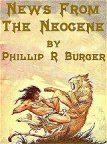
![]()

![]()
![]()

![]()
BILL
HILLMAN
Visit
our thousands of other sites at:
BILL
AND SUE-ON HILLMAN ECLECTIC STUDIO
ERB
Text, ERB Images and Tarzan® are ©Edgar Rice Burroughs, Inc.-
All Rights Reserved.
All
Original Work ©1996-2012/2022 by Bill Hillman and/or Contributing
Authors/Owners
No
part of this web site may be reproduced without permission from the respective
owners.